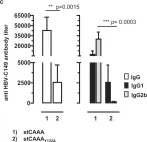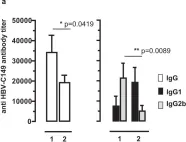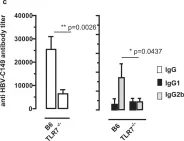RTS,S and R21 are the only vaccines recommended by the WHO to protect children from Plasmodium falciparum (Pf) clinical malaria. Both vaccines target the Pf sporozoite surface protein circumsporozoite protein (CSP). Recent studies showed that human antibodies neutralize Pf sporozoites most efficiently when simultaneously binding to the PfCSP NANP repeat and the NPDP junction domain. However, neither RTS,S nor R21 targets this junction domain. To test the potential of the NPDP junction domain and other sites of PfCSP as innovative vaccine targets, we developed multiple vaccine candidates based on cucumber mosaic virus-like particles (CuMVTT-VLPs). These candidates vary in several aspects: the number of targeted NANP repeats, the presence or absence of the junction domain, the cleavage site, and up to three NVDP repeats within the target sequence. Immunogenicity and efficacy studies were conducted in BALB/c mice, utilizing chimeric Plasmodium berghei (Pb) sporozoites, in which the endogenous CSP has been replaced by PfCSP (Pb/PfCSP). We observed a positive association between the number of targeted NANP repeats and the induction of specific IgM/IgG antibodies. Elevated humoral responses led to enhanced protection against parasitemia after Pb/PfCSP sporozoite challenge. Especially high-avidity/affinity antibody formation and vaccine protection were NANP repeat-dependent. Intriguingly, vaccine efficacy was not enhanced by targeting sites on PfCSP other than the NANP repeats. Our data emphasize the dominant role of the NANP repeat region for induction of protective antibodies. Furthermore, we present here novel malaria vaccine candidates with an excellent immunogenic profile that confer sterile protection in mice, even in absence of adjuvants.
© 2024. The Author(s).
Product Citations: 44
In NPJ Vaccines on 18 November 2024 by Krenger, P. S., Roques, M., et al.
-
Immunology and Microbiology
CT584 Is Not a Protective Vaccine Antigen against Respiratory Chlamydial Challenge in Mice.
In Vaccines on 3 October 2024 by Hoang-Phou, S., Pal, S., et al.
Background:Chlamydia trachomatis is the most prevalent bacterial sexually transmitted pathogen in humans worldwide. Since chlamydial infection is largely asymptomatic with the potential for serious complications, a preventative vaccine is likely the most viable long-term answer to this public health threat. Cell-free protein synthesis (CFPS) utilizes the cellular protein manufacturing machinery decoupled from the requirement for maintaining cellular viability, offering the potential for flexible, rapid, and decentralized production of recombinant protein vaccine antigens. Methods: Here, we use CFPS to produce the full-length putative chlamydial type three secretion system (T3SS) needle-tip protein, CT584, for evaluation as a vaccine antigen in mouse models. High-speed atomic force microscopy (HS-AFM) (RIBM, Tsukuba, Japan) imaging and computer simulations confirm that CFPS-produced CT584 retains a native-like structure prior to immunization. Female mice were primed with CT584 adjuvanted with CpG-1826 intranasally (i.n.) or CpG-1826 + Montanide ISA 720 intramuscularly (i.m.), followed four weeks later by an i.m. boost before respiratory challenge with 104 inclusion forming units (IFU) of Chlamydia muridarum. Results: Immunization with CT584 generated robust antibody responses but weak cell-mediated immunity and failed to protect against i.n. challenge as demonstrated by body weight loss, increased lung weights, and the presence of high numbers of IFUs in the lungs. Conclusion: While CT584 was not a protective vaccine candidate, the speed and flexibility with which CFPS can be used to produce other potential chlamydial antigens make it an attractive technique for antigen production.
-
Immunology and Microbiology
In Allergy on 1 January 2024 by Krenger, P. S., Josi, R., et al.
Virus-like particle (VLP) Peanut is a novel immunotherapeutic vaccine candidate for the treatment of peanut allergy. The active pharmaceutical ingredient represents cucumber mosaic VLPs (CuMVTT -VLPs) that are genetically fused with one of the major peanut allergens, Ara h 2 (CuMVTT -Ara h 2). We previously demonstrated the immunogenicity and the protective capacity of VLP Peanut-based immunization in a murine model for peanut allergy. Moreover, a Phase I clinical trial has been initiated using VLP Peanut material manufactured following a GMP-compliant manufacturing process. Key product characterization studies were undertaken here to understand the role and contribution of critical quality attributes that translate as predictive markers of immunogenicity and protective efficacy for clinical vaccine development.
The role of prokaryotic RNA encapsulated within VLP Peanut on vaccine immunogenicity was assessed by producing a VLP Peanut batch with a reduced RNA content (VLP Peanut low RNA). Immunogenicity and peanut allergen challenge studies were conducted with VLP Peanut low RNA, as well as with VLP Peanut in WT and TLR 7 KO mice. Furthermore, mass spectrometry and SDS-PAGE based methods were used to determine Ara h 2 antigen density on the surface of VLP Peanut particles. This methodology was subsequently applied to investigate the relationship between Ara h 2 antigen density and immunogenicity of VLP Peanut.
A TLR 7 dependent formation of Ara h 2 specific high-avidity IgG antibodies, as well as a TLR 7 dependent change in the dominant IgG subclass, was observed following VLP Peanut vaccination, while total allergen-specific IgG remained relatively unaffected. Consistently, a missing TLR 7 signal caused only a weak decrease in allergen tolerability after vaccination. In contrast, a reduced RNA content for VLP Peanut resulted in diminished total Ara h 2 specific IgG responses, followed by a significant impairment in peanut allergen tolerability. The discrepant effect on allergen tolerance caused by an absent TLR 7 signal versus a reduced RNA content is explained by the observation that VLP Peanut-derived RNA not only stimulates TLR 7 but also TLR 3. Additionally, a strong correlation was observed between the number of Ara h 2 antigens displayed on the surface of VLP Peanut particles and the vaccine's immunogenicity and protective capacity.
Our findings demonstrate that prokaryotic RNA encapsulated within VLP Peanut, including antigen density of Ara h 2 on viral particles, are key contributors to the immunogenicity and protective capacity of the vaccine. Thus, antigenicity and RNA content are two critical quality attributes that need to be determined at the stage of manufacturing, providing robust information regarding the immunogenicity and protective capacity of VLP Peanut in the mouse which has translational relevance to the human setting.
© 2023 The Authors. Allergy published by European Academy of Allergy and Clinical Immunology and John Wiley & Sons Ltd.
-
Immunology and Microbiology
In Nature Communications on 12 September 2023 by Huang, Y., Zhu, L., et al.
The immunomodulatory effects of ultraviolet B (UVB) radiation in human diseases have been described. Whether type 2 lung inflammation is directly affected by solar ultraviolet (UV) radiation is not fully understood. Here, we show a possible negative correlation between solar UVB radiation and asthmatic inflammation in humans and mice. UVB exposure to the eyes induces hypothalamus-pituitary activation and α-melanocyte-stimulating hormone (α-MSH) accumulation in the serum to suppress allergic airway inflammation by targeting group 2 innate lymphoid cells (ILC2) through the MC5R receptor in mice. The α-MSH/MC5R interaction limits ILC2 function through attenuation of JAK/STAT and NF-κB signaling. Consistently, we observe that the plasma α-MSH concentration is negatively correlated with the number and function of ILC2s in the peripheral blood mononuclear cells (PBMC) of patients with asthma. We provide insights into how solar UVB radiation-driven neuroendocrine α-MSH restricts ILC2-mediated lung inflammation and offer a possible strategy for controlling allergic diseases.
© 2023. Springer Nature Limited.
Mast cells link immune sensing to antigen-avoidance behaviour.
In Nature on 1 August 2023 by Plum, T., Binzberger, R., et al.
The physiological functions of mast cells remain largely an enigma. In the context of barrier damage, mast cells are integrated in type 2 immunity and, together with immunoglobulin E (IgE), promote allergic diseases. Allergic symptoms may, however, facilitate expulsion of allergens, toxins and parasites and trigger future antigen avoidance1-3. Here, we show that antigen-specific avoidance behaviour in inbred mice4,5 is critically dependent on mast cells; hence, we identify the immunological sensor cell linking antigen recognition to avoidance behaviour. Avoidance prevented antigen-driven adaptive, innate and mucosal immune activation and inflammation in the stomach and small intestine. Avoidance was IgE dependent, promoted by Th2 cytokines in the immunization phase and by IgE in the execution phase. Mucosal mast cells lining the stomach and small intestine rapidly sensed antigen ingestion. We interrogated potential signalling routes between mast cells and the brain using mutant mice, pharmacological inhibition, neural activity recordings and vagotomy. Inhibition of leukotriene synthesis impaired avoidance, but overall no single pathway interruption completely abrogated avoidance, indicating complex regulation. Collectively, the stage for antigen avoidance is set when adaptive immunity equips mast cells with IgE as a telltale of past immune responses. On subsequent antigen ingestion, mast cells signal termination of antigen intake. Prevention of immunopathology-causing, continuous and futile responses against per se innocuous antigens or of repeated ingestion of toxins through mast-cell-mediated antigen-avoidance behaviour may be an important arm of immunity.
© 2023. The Author(s).
-
Immunology and Microbiology
-
Neuroscience
In Sci Rep on 2 October 2018 by Krieger, J., Stifter, K., et al.
Fig.6.C

-
ELISA
-
Mus musculus (House mouse)
Collected and cropped from Sci Rep by CiteAb, provided under a CC-BY license
Image 1 of 6
In Sci Rep on 2 October 2018 by Krieger, J., Stifter, K., et al.
Fig.7.A

-
ELISA
-
Mus musculus (House mouse)
Collected and cropped from Sci Rep by CiteAb, provided under a CC-BY license
Image 1 of 6
In Sci Rep on 2 October 2018 by Krieger, J., Stifter, K., et al.
Fig.3.A

-
ELISA
-
Mus musculus (House mouse)
Collected and cropped from Sci Rep by CiteAb, provided under a CC-BY license
Image 1 of 6
In Sci Rep on 2 October 2018 by Krieger, J., Stifter, K., et al.
Fig.4.A

-
WB
-
Mus musculus (House mouse)
Collected and cropped from Sci Rep by CiteAb, provided under a CC-BY license
Image 1 of 6
In Sci Rep on 2 October 2018 by Krieger, J., Stifter, K., et al.
Fig.7.C

-
ELISA
-
Mus musculus (House mouse)
Collected and cropped from Sci Rep by CiteAb, provided under a CC-BY license
Image 1 of 6
In Sci Rep on 2 October 2018 by Krieger, J., Stifter, K., et al.
Fig.7.E

-
ELISA
-
Mus musculus (House mouse)
Collected and cropped from Sci Rep by CiteAb, provided under a CC-BY license
Image 1 of 6





